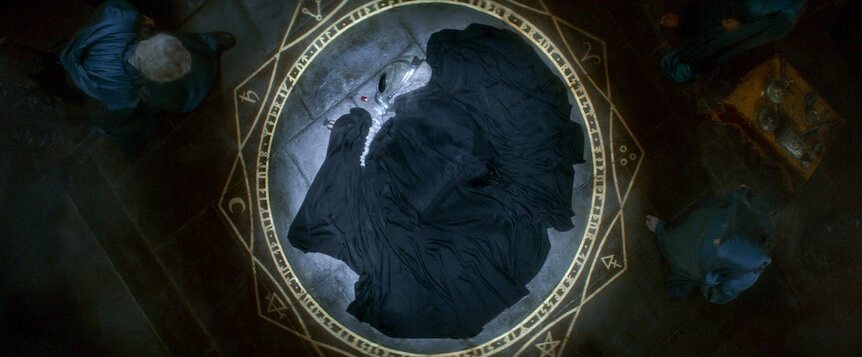'The Sandman' and the science behind sleeping sickness
In Netflix's The Sandman, Dream's imprisonment leaves some people in an endless sleep — not too dissimilar from a real-life disease.

The Sandman, perhaps Neil Gaiman's greatest work, has finally been adapted. While Netflix's recently premiered series makes some changes, the story starts in much the same way. The titular Sandman, a member of the Endless who goes by the names Morpheus or Dream, finds himself accidentally captured by a man who was hoping to apprehend Death. Consequently, much of the world suffers an epidemic of sleeping sickness. Some people are unable to sleep while others are caught in an endless sleep, unable to awaken.
While the events of the story are fantastically fictional, the sleeping sickness which resulted from Dream’s long imprisonment bears a striking resemblance to real-life events.
TRAPPED IN AN ENDLESS DREAM
In the comic, Dream is first captured by Robert Burgess in 1916 and he remains captured for 70 years. (The TV adaptation bumps this to 100 years.) That Gaiman chose to place the beginning of his story in that year appears to have not been an accident. In the winter of 1916, the real world was rocked by a similar epidemic of sleeping sickness — not to mention an unrelated global flu pandemic shortly thereafter — the origin of which isn’t wholly understood.
Encephalitis lethargica, as it came to be known, started in Europe and spread throughout the world. It didn’t last quite as long as is implied in the book or Netflix series, but it did continue through at least the 1930s. Two doctors, Dr. Constantin von Economo from the Psychiatric-Neurological Clinic at the University of Vienna — no relation to the Constantines that populate Sandman’s world — and a French physician named Dr. René Cruchet both encountered the disease at roughly the same time and published descriptions just a few days apart.
There is some evidence that, while it wasn’t officially described until the early twentieth century, incidents of sleeping sickness may have impacted the world several times dating back as early as the 16th century. Whatever the reason or the source, approximately a million people were infected starting in 1916 and roughly half a million of them died as a result. There is, of course, some wiggle room in those numbers for a couple of important reasons.
First, encephalitis lethargica was only a reportable disease in some countries, which meant that a large portion of cases likely went undiagnosed or unreported. Further complicating things, there was no verifiable test, and the diagnosis was a result of observed symptoms and the elimination of other ailments. Moreover, it’s probable that encephalitis lethargica is and was a catch-all for a number of related illnesses, rather than a distinct disease. All told, there were certainly countless cases that remained unidentified and other cases which were diagnosed but were actually something else.
The complications inherent in understanding encephalitis lethargica didn’t stop there. The symptoms were many and varied, with some patients exhibiting severe and rapid symptomology while others were comparatively unfazed. The most common presentation of the disease was the somnolent-ophthalmoplegic form. It progressed rapidly and resulted in patients who were dazed, delirious, and who had a propensity for sleeping often and for long periods of time. Unlike the pandemic shown in Sandman, patients were able to be easily awoken and were even often aware of things that had happened around them while they dozed. At least, that was the case until the disease progressed to the point of death, which was a common outcome. In one case, a patient was asleep within 30 minutes after the onset of the disease and died twelve days later.
If you were able to escape the somnolent-ophthalmoplegic form, you had a higher likelihood of surviving but with an increased rate of long-term symptoms. Two other forms were observed, hyperkinetic and amyostatic-akinetic. The first involved seemingly involuntary muscle twitches and vocalizations followed by weakness, fatigue, and pain in the face and limbs, as well as a reversal of the day-night sleep cycle. The second resulted in patients which were almost motionless, caught in a statue-like state in which they were neurologically active but largely unable to move or communicate.
Both of those forms often resulted in chronic illness which manifested years, and sometimes decades, after the initial infection. Patients experienced Parkinson’s-like symptoms as well as problems sleeping and psychiatric disorders, among others. It’s estimated that in the half a century following the sleeping sickness pandemic, roughly half of all Parkinson’s diagnoses were the consequence of encephalitis lethargica.
What caused the outbreak of encephalitis lethargica more than a century ago and why it ultimately ended remain unclear and the opportunity for continued study has diminished. Today, there aren’t many cases, but there are some. A 2004 study in the journal Brain described 20 new cases in the current century. It seems that Dream has remained out of his cage but is still tapping the minds of a select few. Perhaps one day medical science will find a way to placate the Lord of the Dreaming and end encephalitis lethargica forever. In the meantime, we hope you sleep well.
Season 1 of The Sandman is now streaming on Netflix.





























